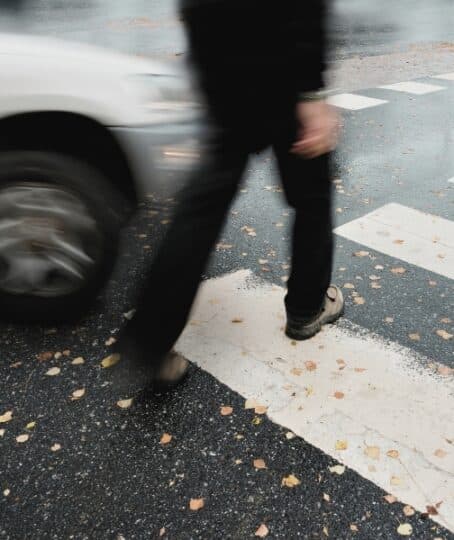
When a Dog Attacks Again and Again If dogs attack once, it’s alarming. When they attack five times, it’s no...


Often, drivers are at fault when a car hits a pedestrian who is jaywalking. The at-fault driver may be liable for medical expenses and other costs associated with the pedestrian’s injury. The behavior of both parties at the time of an accident, however, will be considered when determining who is responsible for injuries sustained by a pedestrian.

Illinois, like other states, has laws in place to help avoid pedestrian accidents and protect those who share the road with vehicles. Just as pedestrians can expect drivers to follow the rules of the road, drivers typically expect pedestrians to adhere to these laws.
Pedestrians should wait until it's safe to enter the crosswalk. When using public streets and walkways, pedestrians have to obey all traffic signals and use crosswalks.
Pedestrians should use sidewalks when walking on the road if possible. If there is no sidewalk, they should walk on the side of the road that faces the oncoming traffic. When using the roads on foot, pedestrians should not immediately enter the road in a way that creates a hazard. If an accident occurs when a drunk or intoxicated pedestrian enters the roadway, the pedestrian might be liable for the damages.
On unmarked crosswalks, pedestrians have the right of way. When a pedestrian accident happens in a parking lot, the driver could be found liable if he or she was drunk or distracted.
If there are no stop signs or signals, drivers should slow down and take account of the cars coming from all directions. Drivers should stop when making turns at intersections. Further, all drivers must yield and stop when turning on a red light. The driver can turn toward the traffic near him or her at a red light, but the way must be clear.
Drivers must give way to pedestrians when they enter or leave a street or highway from a building or driveway. Most importantly, cars should yield and stop when pedestrians cross the road with a green light. Drivers should yield and stop when a pedestrian is approaching the marked crosswalk. Cars should stop when children are near a school zone-designated crosswalk.
Drivers should similarly stop at the intersection when there is a red traffic signal and a person on foot gets to the crosswalk before the traffic signal changes. If a driver hits a pedestrian on the crosswalk, he or she may be found at fault and liable for damages.
Illinois crosswalk law covers who's at fault if you hit a jaywalker, and failure to comply can lead to fines and penalties whether it leads to an accident or not.
The liability of a driver in a pedestrian accident involving jaywalking depends on the circumstances of the accident. If drivers do not adhere to the pedestrian and traffic laws, they may bear financial responsibility for any damages resulting from a crash, even if the pedestrian takes on some of the fault by jaywalking.
Common reasons drivers may be found at fault for hitting pedestrians who are jaywalking include:
If you get hit by a car because of distracted driving, the court may find the driver liable for your injuries. While behind the wheel, drivers must use care to avoid distracting behaviors, such as those that take their attention off driving, eyes off the road, or hands off the wheel. Cognitive, visual, and manual distractions, including eating, drinking, talking on a cellphone or to a passenger, and changing the radio station, may affect motorists’ ability to respond to situations on the road.
Drivers may be at-fault for pedestrian accidents if they are under the influence of alcohol at the time of the crash.
Motorists who have been drinking alcohol may have an increased risk of getting into a car accident. The increased risk is largely due to the effects of alcohol on the body, and the resultant effects on drivers, such as experiencing slowed reaction time, impaired vision, or trouble maintaining control of their vehicle.
Speed is a factor in many car accidents. At excessive rates of speed, drivers may be more apt to lose control of their vehicles. Further, when you're driving at a high rate of speed, it takes longer for your vehicle's tires to stop spinning when they hit something like ice or rain; making it harder for drivers to react quickly enough.
Higher rates of speed will also give collisions greater force, which may result in more severe injuries for those involved.
If you were injured in a jaywalking accident, you may have grounds to file a personal injury claim that includes compensation for:
Personal injury lawsuits involving jaywalking accidents can take many forms.
The most common type of personal injury lawsuit is a negligence action, which occurs when one party causes harm to another through careless behavior. To prove negligence, you must show that:
The driver owed you a duty of care. When they get behind the wheel, drivers take on a responsibility to safely operate their vehicles, a duty they owe to you and the others with whom they share the road.
Next, you must show a breach of this duty occurred. To this end, you must prove the defendant failed to act reasonably under the circumstances. Your case will also need to show that you were harmed as a result of this breach, and experienced compensable damages.
If you are jaywalking and get hit by a car, you may bear some fault for causing the accident. Just because a car hit a pedestrian who is jaywalking does not, however, bar the pedestrian from recovering damages.
Illinois follows a comparative fault rule. As such, you can recover compensation for your injury-associated losses, provided you are not more than 50% at-fault for causing the accident. However, your damages will be diminished by the percentage of fault you carry.
For example, a car hit a pedestrian who is jaywalking, but the driver was speeding at the time of the crash and ran a red light. The court determines the pedestrian was 20% responsible. If he or she was entitled to recover $100,000 in damages, the court will reduce the amount by 20% to $80,000.

When a Dog Attacks Again and Again If dogs attack once, it’s alarming. When they attack five times, it’s no...

Overview of the Personal Injury Claim Process in Illinois No one expects to suffer an injury or get involved in...

Exploring Caps on Damages in Illinois Personal Injury Cases Illinois does not have laws capping damages in successful personal injury...